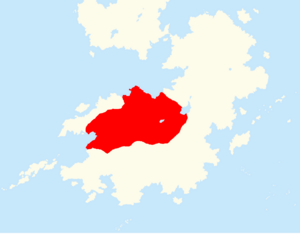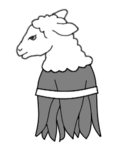Togoti Khaganate: Difference between revisions
mNo edit summary |
mNo edit summary |
||
| (16 intermediate revisions by 2 users not shown) | |||
| Line 4: | Line 4: | ||
|conventional_long_name = Hosts and Realms of the Bashtug | |conventional_long_name = Hosts and Realms of the Bashtug | ||
|common_name = Togoti Khaganate | |common_name = Togoti Khaganate | ||
|era = | |era = Togoti Era | ||
|status = | |status = {{wp|Empire}} | ||
|status_text = <!-- A free text to describe status at the top of the infobox. Use sparingly. --> | |status_text = <!-- A free text to describe status at the top of the infobox. Use sparingly. --> | ||
|empire = <!-- The empire or country to which the entity was in a state of dependency --> | |empire = <!-- The empire or country to which the entity was in a state of dependency --> | ||
| Line 51: | Line 51: | ||
|s2 = Khardarid Khanate | |s2 = Khardarid Khanate | ||
|image_s2 = | |image_s2 = | ||
|s3 = | |s3 = Akdoğan Khanate | ||
|image_s3 = | |image_s3 = | ||
|image_flag = Togot_tug.png | |image_flag = Togot_tug.png | ||
|flag_alt = <!-- Alt text for flag --> | |flag_alt = <!-- Alt text for flag --> | ||
| Line 70: | Line 66: | ||
|symbol_type = <!-- Displayed text for link under symbol. Default "Coat of arms" --> | |symbol_type = <!-- Displayed text for link under symbol. Default "Coat of arms" --> | ||
|symbol_type_article = <!-- Link target under symbol image. Default: Coat of arms of {{{common_name}}} --> | |symbol_type_article = <!-- Link target under symbol image. Default: Coat of arms of {{{common_name}}} --> | ||
|image_map = | |image_map = [[File:Togoti Khaganate map.png|300px]] | ||
|image_map_alt = | |image_map_alt = | ||
|image_map_caption = | |image_map_caption = The Togoti Khaganate at its maximum extent before the death of Gurkhan in 1662. | ||
|image_map2 = <!-- If second map is needed; does not appear by default --> | |image_map2 = <!-- If second map is needed; does not appear by default --> | ||
|image_map2_alt = | |image_map2_alt = | ||
| Line 92: | Line 88: | ||
|year_leader2 = 1511-1526 | |year_leader2 = 1511-1526 | ||
|year_leader3 = | |year_leader3 = | ||
|year_leader4 = | |year_leader4 = 1633-1662 | ||
|title_leader = Khagan | |title_leader = Khagan | ||
|representative1 = <!-- Name of representative of head of state (e.g. colonial governor) --> | |representative1 = <!-- Name of representative of head of state (e.g. colonial governor) --> | ||
| Line 137: | Line 133: | ||
|footnote_a = <!-- Accepts wikilinks --> | |footnote_a = <!-- Accepts wikilinks --> | ||
|footnote_b = <!-- Accepts wikilinks --> | |footnote_b = <!-- Accepts wikilinks --> | ||
|footnote_h = <!-- Accepts wikilinks --> | |footnote_h = <!-- Accepts wikilinks --> | ||
|footnotes = <!-- Accepts wikilinks --> | |footnotes = <!-- Accepts wikilinks --> | ||
| Line 143: | Line 138: | ||
{{WIP}} | {{WIP}} | ||
The '''Togoti Khaganate''', which was known domestically as the '''Hosts and Realms of the Bashtug''' (බස්හ්තුගිඉන් තුමේනුඋද් බ තල්බෛනුඋද්, ''Bashtugiin Tumenuud Ba Talbainuud''), was an empire that arose in the northwestern region of the [[Great Steppe]] during the late 15th century and established the largest steppe empire in history. At the height of its power in the early 17th century, the Togoti Khaganate controlled all of [[Ajahadya]], [[Chanda]], and [[Kumuso]] as well as large parts of [[Union of Zorasani Irfanic Republics|Zorasan]] and [[Baekjeong]]. | The '''Togoti Khaganate''', which was known domestically as the '''Hosts and Realms of the Bashtug''' (බස්හ්තුගිඉන් තුමේනුඋද් බ තල්බෛනුඋද්, ''Bashtugiin Tumenuud Ba Talbainuud''), was an [[Togoti]] empire that arose in the northwestern region of the [[Great Steppe]] in modern day [[Ajahadya]] during the late 15th century and established the largest steppe empire in history. At the height of its power in the early 17th century, the Togoti Khaganate controlled all of [[Ajahadya]], [[Chanda]], [[Gulbistan]], and [[Kumuso]] as well as large parts of [[Union of Zorasani Irfanic Republics|Zorasan]] and [[Baekjeong]]. | ||
The Togti Khaganate was declared in 1479 after the Togti Khanate's conquest of [[Khorshid Confederacy]] | The Togti Khaganate was declared by [[Tsustemori Khan]] in 1479 after the Togti Khanate's conquest of [[Khorshid Confederacy]]. The eponymous "bashtug", composed of a {{wp|tug (banner)|tug}} and a sheep head, was a personal symbol adopted by Tsustemori Khan after the declaration of the Khaganate. Over the next two centuries the empire grew rapidly, establishing an Khaganate that stretched from northern [[Baekjeong]] in the south to northwest [[Zorasan]] in the north and [[Ajahadya]] in the west to [[Kumuso]] in the east. The vast and multi-ethnic nature of the empire allowed the dissemination and exchange of trade, technologies, commodities and ideologies across [[Coius]] as well enabling the migration of many peoples across the continent. | ||
After the death of | After the death of [[Gurkhan]] in the invasion of [[Xiaodong]], the Khaganate collapsed into a civil war between his two sons [[Ajahad]] and [[Khardar]]. The war led to a severe and rapid collapse of the Khaganate's power as it lost large amounts of territory to a series of invasions by neighboring states and rebellions. A notable rebellion was led by [[Akdoğan]], a powerful general stationed in modern-day [[Chanda]]. Instead of fighting in the civil war, he used it as an opportunity to establish his own fiefdom which would become the [[Akdoğan Khanate]]. After two years of confict, Gurkhan's sons eventually agreed to split the remnants of the empire between them, creating the [[Rajadom of Ajahadya]] and the [[Khardarid Khanate]]. The split in 1665 marked the end of the Khaganate, with the two main remnants pursuing their own interests and objectives. | ||
The Karadarid Khanate would exist only for a couple decades until its conquest by the [[Second Gorsanid Empire]]. Meanwhile the Rajadom of Ajahadya continued to exist until coup and the resulting [[Ajahadyan Civil War]] led to the formation of a republic in 1935. The [[ | The Karadarid Khanate would exist only for a couple decades until its conquest by the [[Second Gorsanid Empire]]. Meanwhile the Rajadom of Ajahadya, the direct predecessor to the modern state of [[Ajahadya]], continued to exist until a coup and the resulting [[Ajahadyan Civil War]] led to the formation of a republic in 1935. The [[Akdoğan Khanate]] continued to rule until the vassalisation of the Khanate by the [[Heavenly Xiaodongese Empire]] in the late 19th century. | ||
==Name== | ==Name== | ||
==History== | ==History== | ||
Latest revision as of 20:09, 17 May 2021
Hosts and Realms of the Bashtug බස්හ්තුගිඉන් තුමේනුඋද් බ තල්බෛනුඋද් (Bashtugiin Tumenuud Ba Talbainuud) | |||||||||||||||||||||
|---|---|---|---|---|---|---|---|---|---|---|---|---|---|---|---|---|---|---|---|---|---|
| 1497–1665 | |||||||||||||||||||||
|
Lamb's Head Tug | |||||||||||||||||||||
 The Togoti Khaganate at its maximum extent before the death of Gurkhan in 1662. | |||||||||||||||||||||
| Status | Empire | ||||||||||||||||||||
| Religion | Badi | ||||||||||||||||||||
| Government | Absolute monarchy | ||||||||||||||||||||
| Khagan | |||||||||||||||||||||
• 1497-1511 | Tsustemori | ||||||||||||||||||||
• 1511-1526 | Monkhonkh | ||||||||||||||||||||
• | ... | ||||||||||||||||||||
• 1633-1662 | Gurkhan | ||||||||||||||||||||
| Historical era | Togoti Era | ||||||||||||||||||||
• Consolidation of Mirghazab | 1497 | ||||||||||||||||||||
• Death of Tsustemori Khan | 1511 | ||||||||||||||||||||
• Conquest of the Lower Steppe | 1527 | ||||||||||||||||||||
• Western Campaigns | 1547 | ||||||||||||||||||||
• Battle of Saqalaskar | 1662 | ||||||||||||||||||||
• Fragmentation | 1665 | ||||||||||||||||||||
| |||||||||||||||||||||
This article is incomplete because it is pending further input from participants, or it is a work-in-progress by one author. Please comment on this article's talk page to share your input, comments and questions. Note: To contribute to this article, you may need to seek help from the author(s) of this page. |
The Togoti Khaganate, which was known domestically as the Hosts and Realms of the Bashtug (බස්හ්තුගිඉන් තුමේනුඋද් බ තල්බෛනුඋද්, Bashtugiin Tumenuud Ba Talbainuud), was an Togoti empire that arose in the northwestern region of the Great Steppe in modern day Ajahadya during the late 15th century and established the largest steppe empire in history. At the height of its power in the early 17th century, the Togoti Khaganate controlled all of Ajahadya, Chanda, Gulbistan, and Kumuso as well as large parts of Zorasan and Baekjeong.
The Togti Khaganate was declared by Tsustemori Khan in 1479 after the Togti Khanate's conquest of Khorshid Confederacy. The eponymous "bashtug", composed of a tug and a sheep head, was a personal symbol adopted by Tsustemori Khan after the declaration of the Khaganate. Over the next two centuries the empire grew rapidly, establishing an Khaganate that stretched from northern Baekjeong in the south to northwest Zorasan in the north and Ajahadya in the west to Kumuso in the east. The vast and multi-ethnic nature of the empire allowed the dissemination and exchange of trade, technologies, commodities and ideologies across Coius as well enabling the migration of many peoples across the continent.
After the death of Gurkhan in the invasion of Xiaodong, the Khaganate collapsed into a civil war between his two sons Ajahad and Khardar. The war led to a severe and rapid collapse of the Khaganate's power as it lost large amounts of territory to a series of invasions by neighboring states and rebellions. A notable rebellion was led by Akdoğan, a powerful general stationed in modern-day Chanda. Instead of fighting in the civil war, he used it as an opportunity to establish his own fiefdom which would become the Akdoğan Khanate. After two years of confict, Gurkhan's sons eventually agreed to split the remnants of the empire between them, creating the Rajadom of Ajahadya and the Khardarid Khanate. The split in 1665 marked the end of the Khaganate, with the two main remnants pursuing their own interests and objectives.
The Karadarid Khanate would exist only for a couple decades until its conquest by the Second Gorsanid Empire. Meanwhile the Rajadom of Ajahadya, the direct predecessor to the modern state of Ajahadya, continued to exist until a coup and the resulting Ajahadyan Civil War led to the formation of a republic in 1935. The Akdoğan Khanate continued to rule until the vassalisation of the Khanate by the Heavenly Xiaodongese Empire in the late 19th century.
